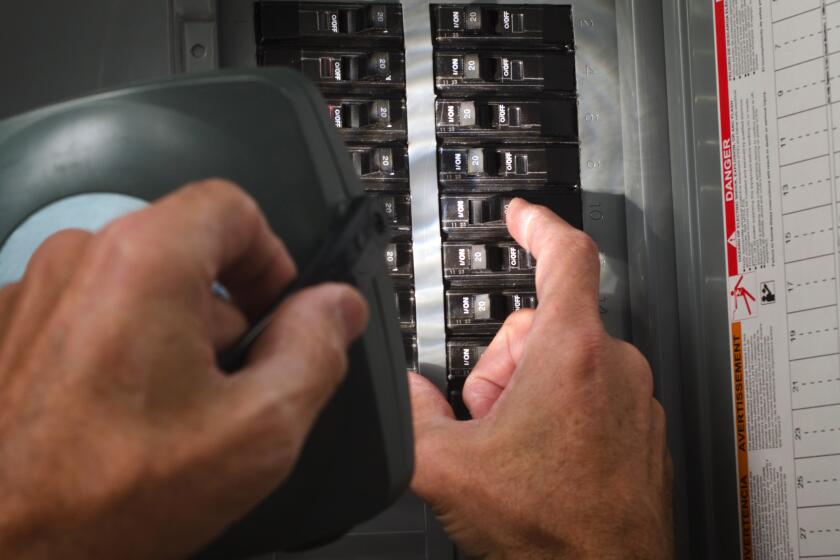State revises proposed bullet train routes, but San Fernando Valley communities remain skeptical

The mountainous area above the Tujunga Wash in Sunland is one proposed route where engineers would bore a tunnel for the bullet train on the Palmdale to Burbank Alignment.
The California rail authority has proposed major bullet-train route changes that would put more of it underground as it crosses the San Fernando Valley, avoiding some of the impacts of aboveground routes that have drawn strong protests.
High-Speed Rail Authority Chairman Dan Richard said Thursday the state is committed to mitigating the effects on low-income communities as a matter of “environmental justice.”
After a public meeting held by the San Fernando Valley Council of Governments, it was clear that the new plan would continue to receive resistance from the communities, even though it would avoid bisecting neighborhoods in several cases.
“The fight is not over,” Georgina Carranza, a Valley resident who has been active in the matter, told the council. “We are standing with our neighbors in Shadow Hills and Sun Valley.”
The difficult passage from Burbank to Palmdale involves the geologically complex San Gabriel Mountains, where aquifers, faults and shattered rock formations will increase the difficulty of tunneling.
The number of possible routes is down to three in the new plan.
The plan makes significant modifications to one of the earlier possible routes as it follows Highway 14. The old plan would have put tracks above ground through Pacoima, San Fernando, Sylmar and Santa Clarita, a possibility that drew hundreds of protesters to a board meeting last summer in downtown Los Angeles.
The new route along Highway 14 goes underground south of Pacoima and would not surface until north of Santa Clarita.
A second possible route also now goes underground south of Pacoima.
The third route would still run aboveground through Sun Valley, Shadow Hills and Lakeview Terrace neighborhoods.
The rail authority also dropped one of three plans to take the rail through tunnels under the Angeles National Forest, but the plan largely leaves in place two other forest routes.
The new plan drew praise from some officials in the communities. But they continued to urge the state to find underground routes that would fully eliminate the rail’s impact on the equestrian communities along the Tujunga Wash and other communities in Sunland.
Michael Murphy, intergovernmental relations manager for Santa Clarita, said the city appreciated steps the rail authority has taken, but said the City Council is on record supporting a fully underground alignment from Palmdale to Burbank. The city is still evaluating the new plan, Murphy said.
“It needs to be a broader commitment,” he said.
The rail authority estimates the new routes will require 22 to 24 miles of tunnels under the local mountains, which would be the most ambitious tunneling project in the nation’s history. That compares with about 20 miles that it estimated last year, though on Thursday the authority said the old plan actually required 21 to 23 miles. So, the new plan adds an extra mile or two of tunnels, which could increase project costs by an unknown amount.
At the meeting, Richard said the rail authority had reconsidered the alternative routes in direct response to community concerns. “This is a very challenging job to go through this area,” he said.
Richard said the state could not eliminate all the impacts and noted that the authority has held firm on its route planning in the wealthy Bay Area community of Atherton, which has filed environmental lawsuits. “We have told them this is where the rail should go,” he said.
Richard, a resident of the Bay Area, said his exposure to the communities from Palmdale to Burbank had become a “real area of education for me” as he has met with residents and elected officials.
But several dozen residents and officials continued to press for more concessions. Speaking to the council of governments, they noted that at least two endangered species depend on the ecosystem along the washes that flow out of the Angeles National Forest.
“The Tujunga Wash is a national treasure,” said George Gamble, a Shadow Hills resident. “The natural springs accommodate wildlife. I am fearful of the impact of any high-speed rail construction on this fragile ecosystem.”
After the protests last year, the rail authority agreed to conduct a series of expedited studies to determine the seismic challenge of the route and how much impact it would have on the horse communities and mountain aquifers.
The authority tapped the Mineta Transportation Institute to conduct the equestrian study, which found that effects on horses would be minimal. Richard noted that studies in Europe found that cows became acclimated to the noise of bullet trains.
A number of horse owners at Thursday’s meeting took exception to comparing cows to horses and demanded a new study. They asserted the institute was not independent, since rail authority Chief Executive Jeff Morales and former rail authority board member Rod Diridon both serve on the institute’s board.
The route would pass through one of the largest equestrian communities in Southern California, where an estimated 25,000 horses are boarded, according to Dale Gibson, a rodeo cowboy who serves on the Los Angeles Equine Advisory Board.
Two organized labor officials praised the new plan, saying the project would create badly needed jobs.
Twitter: @rvartabedian
ALSO
Meet the Israelis praying for a Trump win
UC Merced attacker was inspired by Islamic State, FBI says
Worker dies after falling 53 stories from downtown L.A. high-rise
More to Read
Sign up for Essential California
The most important California stories and recommendations in your inbox every morning.
You may occasionally receive promotional content from the Los Angeles Times.







